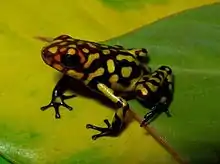Harlequin poison frog
The harlequin poison frog, also known as harlequin poison-dart frog (Oophaga histrionica), is a species of poison dart frog endemic to the Chocó region of western Colombia.[2] The frog is normally found on the ground of tropical rain forests, among fallen limbs or leaf litter.[1]
| Harlequin poison frog | |
|---|---|
 | |
| Scientific classification | |
| Kingdom: | Animalia |
| Phylum: | Chordata |
| Class: | Amphibia |
| Order: | Anura |
| Family: | Dendrobatidae |
| Genus: | Oophaga |
| Species: | O. histrionica |
| Binomial name | |
| Oophaga histrionica (Berthold, 1845) | |
| Synonyms | |
|
Dendrobates histrionicus Berthold, 1845 | |
Description
The harlequin poison frog has a variety of color morphs, which differ from one valley to the next in its native range.[3] The base color is a bright orange, with a webbing of black over the entire body. Of the color morphs, the base color may be of clear to dull orange, yellow, red, white, or blue. The web pattern varies from small lines to big lines or speckled, incomplete lines, or a completely black frog with just a few spots. The various color morphs can be found in surprisingly close proximity, with different populations on adjacent hillsides.
Life history
The harlequin poison frog lives on the forest floor. The male calls from a low perch to advertise his presence and the female lays eggs among the leaf litter. When the eggs hatch, a parent transports the newly hatched tadpoles to a tiny water reservoir (often in the axil of a bromeliad). The mother returns periodically and lays unfertilized eggs, on which the tadpoles feed until ready to metamorphose and exit the water. The larva is an obligate egg-feeder and will starve without this form of nutrition.[4]Feeding from ants and mites on the ground is popular after sunrise and not later than 16:00, when people are either on the ground or elevated on fallen logs finding refugee under leaf litter.[5]Feeding from ants and mites on the ground is popular after sunrise and not later than 16:00, when people are either on the ground or elevated on fallen logs finding refugee under leaf litter[6]
This rearing behavior makes harlequins among the most difficult poison dart frogs to raise in captivity. As a result, they are not widely found on the domestic pet market, and those available may be illegally smuggled imports rather than legally bred domestic animals. Wild-caught dart frogs are often stressed, require more care, have a much higher fatality rate, and may also be toxic and dangerous to handle. A few domestically bred animals are nevertheless available and are highly sought-after in the pet trade.[7][8]
Poison
O. histrionica, along with O. speciosa, produces cardiotoxins known as histrionicotoxins. These moderate to highly toxic compounds act as potent noncompetitive antagonists of nicotinic acetylcholine receptors, binding to a regulatory site on the delta subunit of the ion channel complex. They also have some affinity for sodium and potassium channels, although they are much less potent for these targets. The synthesis of histrionicotoxins and various homologues is synthetically challenging and has been the subject of many different attempts.
Status
The IUCN has listed this species as being "Critically Endangered". There is ongoing destruction of its rainforest habitat and its numbers seem to be declining.[1]
References
- IUCN SSC Amphibian Specialist Group 2019. Oophaga histrionica. The IUCN Red List of Threatened Species 2019: e.T144231367A144443857. Downloaded on 21 July 2019.
- Frost, Darrel R. (2014). "Oophaga histrionica (Berthold, 1845)". Amphibian Species of the World: an Online Reference. Version 6.0. American Museum of Natural History. Retrieved 4 September 2014.
- http://animaldiversity.ummz.umich.edu/site/accounts/information/Dendrobates_histrionicus.html
- Fran Sandmeier (2011-11-09). "Oophaga histrionica". AmphibiaWeb. Retrieved 2013-12-22.
- Posso, Terranova, Andrés, and Jose Andrés. “Multivariate Species Boundaries and Conservation of Harlequin Poison Frogs.” Molecular Ecology, vol. 27, no. 17, Sept. 2018, pp. 3432–3451. EBSCOhost, doi:10.1111/mec.14803.
- Posso, Terranova, Andrés, and Jose Andrés. “Multivariate Species Boundaries and Conservation of Harlequin Poison Frogs.” Molecular Ecology, vol. 27, no. 17, Sept. 2018, pp. 3432–3451. EBSCOhost, doi:10.1111/mec.14803.
- Zamora, Z.; Gagliardo, R.; Nishihira, C. (1999). "Harlequin Poison Dart Frogs". The Vivarium. 10 (4): 22–27.
- Staniszewski, M. (1995). Amphibians in Captivity. Neptune City, New Jersey: T.F.H. Publications.
External links
| Wikispecies has information related to Oophaga histrionica. |
![]() Media related to Oophaga histrionica at Wikimedia Commons
Media related to Oophaga histrionica at Wikimedia Commons
